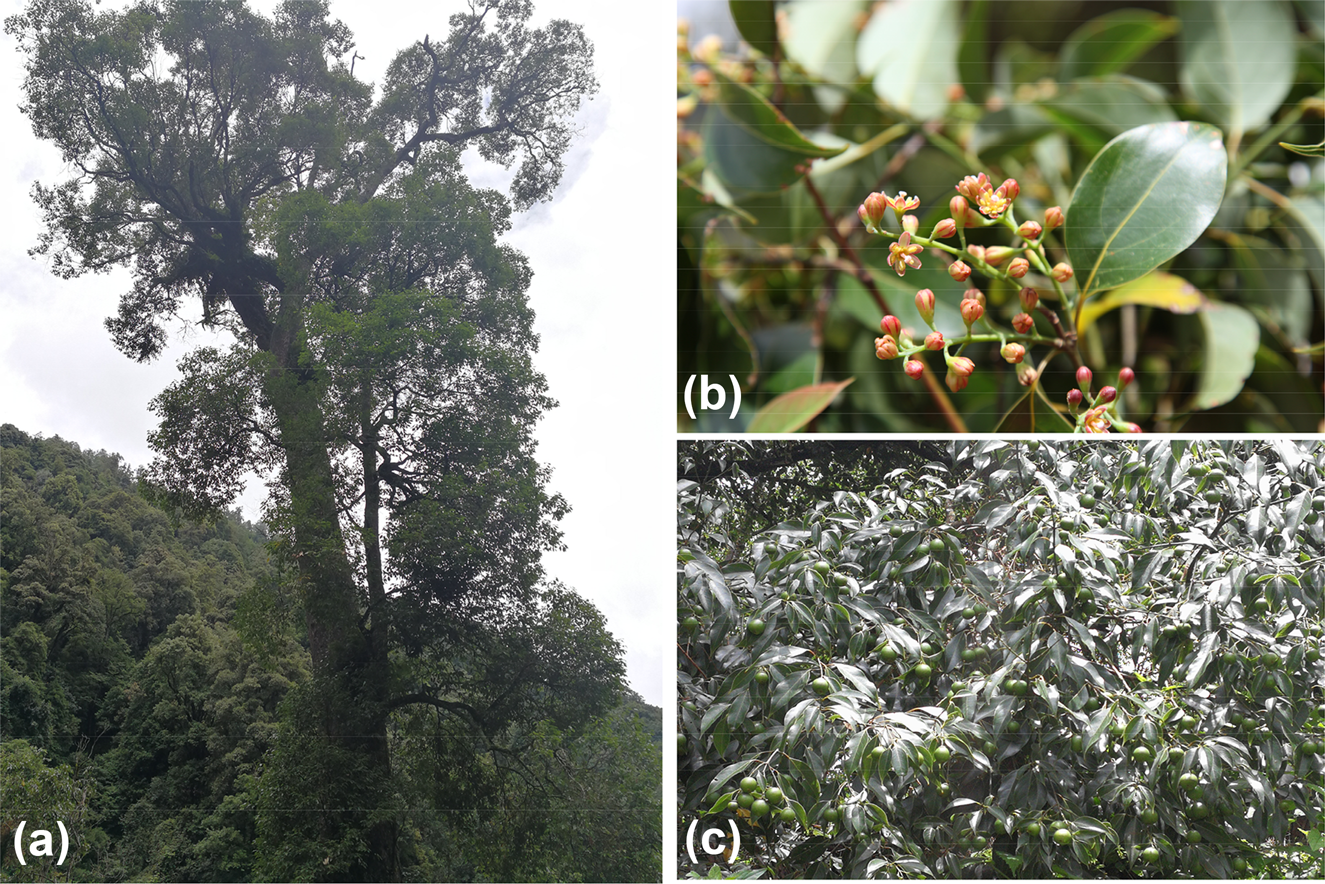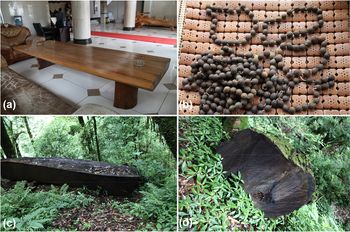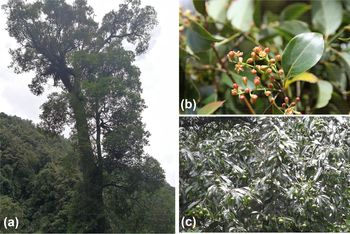China is a high priority for biodiversity conservation, with > 30,000 vascular plant species, of which c. 10,000 are endemics (Yang et al., Reference Yang, Zhu, Hong, Wu and Raven2005; Volis, Reference Volis2016). In Yunnan province 1,010 stenochoric endemic seed plants have been recorded (Wu et al., Reference Wu, Sun, Zhou, Li and Peng2011; Liu & Peng, Reference Liu and Peng2016). Species of the family Lauraceae have significant ecological and economic value (Ravindran et al., Reference Ravindran, Nirmal-Babu and Shylaja2003; Huang et al., Reference Huang, Li, van der Werff, Li, Rohwer and Crayn2016; Zhang et al., Reference Zhang, Zhang, Wang and Shen2018), with a total of 445 species (316 endemic) recorded in China, of which 109 are categorized as Endangered on the China Species Red List (Wang & Xie, Reference Wang and Xie2004; Yang & Liu, Reference Yang and Liu2015). The Lauraceae species Cinnamomum chago was first found in La-Guo village, Yunnan province, in 1988 (Sun & Zhao, Reference Sun and Zhao1991), where it is a resource for timber and edible nuts (Plate 1). Its morphological features (opposite leaves, pinnate leaf veins, naked bud and no glandular fossa) and phylogenetic analysis indicate that it is a key species in the phylogeny and evolution of Cinnamomun (Plate 2; Dong et al., Reference Dong, Zhang, Yang, Wang and Shen2016; Huang et al., Reference Huang, Li, van der Werff, Li, Rohwer and Crayn2016).

Plate 1 Furniture made from the wood of C. chago (a), seeds traded in an agricultural market (b), and felled individuals (c & d).

Plate 2 Cinnamomum chago (a), and its flowers (b) and fruits (c).
Lack of information on the distribution and status of a threatened endemic species can impede its conservation (Fenu et al, Reference Fenu, Mattana and Bacchetta2011; Wang et al., Reference Wang, Ma, Chen, Li, Dao and Sun2016; Laguardia et al., Reference Laguardia, Kamlera, Lia, Zhanga, Zhoua and Shia2017). Previously, C. chago was known only from La-Guo village, at c. 2,300 m altitude (Sun & Zhao, Reference Sun and Zhao1991). It is listed as one of the 321 Plant Species with Extremely Small Populations in south-west China that require comprehensive surveys and germplasm conservation (Yang & Sun, Reference Yang and Sun2017). As it had been suggested that C. chago could occur in other areas of Yunnan (Dong et al., Reference Dong, Zhang, Yang, Wang and Shen2016), we surveyed to characterize its distribution and habitat, identify any threats, assess its conservation status using the Red List categories and criteria (IUCN, 2012, 2017; Hoffman et al., Reference Hoffman, Brooks, Dafonseca, Gascon, Hawkins and James2008; Fenu et al., Reference Fenu, Mattana and Bacchetta2011), and provide guidelines for its management and conservation.
We firstly noted the characteristics of the specimens of C. chago deposited in the herbarium of Yunnan University, and verified the historical collection site in La-Guo village. We compiled information on C. chago from the literature and from experts, to identify sites where the species could potentially occur. At each potential site we showed photographs of the herbarium specimens and described the species' characteristics to local villagers and foresters. We received infomation regarding eight potential sites in Dali Prefecture, which we surveyed during the flowering (April–May) and fruiting seasons (September–October) of 2014–2017, noting the locations of any C. chago with a GPS, and the number of mature individuals, altitude and habitat type. The extent of occurrence and area of occupancy (IUCN, 2012, 2017), the latter using a 4 km2 grid, were determined with ArcGIS 10.3 (Esri, Redlands, USA).
We found 64 mature C. chago in five locations, in 120 days of surveys (Table 1). All populations, except that at La-Guo, are new discoveries (Fig. 1). The five populations occur in the mountains along Lancang River in Dali Prefecture, at altitudes of 2,200–2,400 m. The total extent of occurrence is 923.23 km2 and the area of occupancy is 60.19 km2 (Table 1). The greatest distance between populations is 82.05 km, between Da-Shi-Ba and Xin-Cun, and the shortest distance (< 1 km) is between Shun-Bi-Xiang and Xin-Cun (Fig. 1).

Fig. 1 The locations in which Cinnamomum chago was located in Yunnan province (La-Guo, where the species was first found, and four additional locations).
Table 1 Locations in which we confirmed the occurrence of Cinnamomum chago in Yunnan province, China, with geographical coordinates, altitude, number of mature individuals, area of occupancy and habitat type.

Habitat quality is important for the long-term persistence and survival of threatened plant species (Shen et al., Reference Shen, Wang, Wang, Ma, Shen and Han2009). The habitat of C. chago is of two types: secondary evergreen broadleaved forest and Juglans regia plantations. The populations in plantations (Table 1) are potentially exposed to high-frequency anthropogenic disturbance. None of the five populations lie within a protected area.
Expansion of pastoral activities and deforestation, and commercial utilization of the seeds and wood of C. chago, were detected in all five locations. In Nan-Mu-Ping C. chago had been felled to make furniture and other items. In all locations mature seeds of C. chago were collected by villagers and sold after processing. We found mature seeds gnawed by rodents, especially in Shun-Bi-Xiang, Xin-Cun and La-Guo, which are near villages. Our preliminary germination test indicated that the seeds of C. chago have deep dormancy, and our field observations indicate that healthy mature seeds begin to germinate under natural conditions in 1–2 years and that the germination rate is < 0.1%. We hypothesize that overexploitation is one of the most significant threats to C. chago, as a result of which, combined with slow germination, regeneration is probably poor. We did not observe any seedlings or saplings of C. chago.
In summary, we found < 100 mature C. chago, and its habitat has been degraded by human disturbance, confirming this is a species with an extremely small population (Sun, Reference Sun2013). Cinnamomum chago was not included in the Threatened Species List of China's Higher Plants (Qin et al, Reference Qin, Yang, Dong, He, Jia and Zhao2017). We recommend categorization as Endangered based on IUCN Red List criteria (IUCN, 2012) 2ab(i,ii,iii,v), and make three additional recommendations. Firstly, the local forestry department needs to prevent the collection of the seeds and wood of C. chago. Secondly, as all located individuals occur outside protected areas, each population requires protection and monitoring (this strategy is already being implemented for other species with extremely small populations that do not lie in National Nature Reserves; Wang et al., Reference Wang, Ma, Chen, Li, Dao and Sun2016, Reference Wang, Zhang, Wan, Qu, Mu and Zhang2017). Thirdly, as reintroduction has been successfully employed for other plant species with extremely small populations (Wade et al., Reference Wade, Nadarajan, Yang, Ballesteros, Sun and Pritchard2016), such as Euryodendron excelsum (Shen et al., Reference Shen, Wang, Zhang, Wu and Jiang2013), Magnolia sinica (Wang et al., Reference Wang, Ma, Chen, Li, Dao and Sun2016) and Primulina tabacum (Ren et al., Reference Ren, Ma, Zhang, Guo, Wang and Wang2010), seedlings should be propagated ex situ for this purpose.
Acknowledgements
This study was funded by the Surveys and Germplasm Conservation of Plant Species with Extremely Small Populations project in south-west China (2017FY100100) under the Science & Technology Basic Resources Investigation Programme, the National Key Research and Development Project (2017YFC0505204), the National Natural Science Foundation (31560224 and 31560224), the Young Academic and Technical Leader Raising Foundation of Yunnan Province (2018HB035), and the academic award for new doctoral candidates in Yunnan province (C6155501). We thank the administration of the local forestry department and Xu Peng of Xincun village for help with the survey.
Author contributions
Secured funding, study design: S-KS, Y-HW; fieldwork and data analysis: all authors; writing and revision: XZ, S-KS.
Conflicts of interest
None.
Ethical standards
This research abided by the Oryx guidelines on ethical standards.






